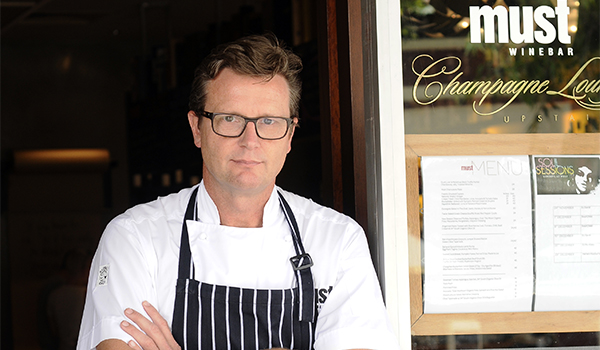Russell Blaikie shares five wines that have had a lasting impact along the way.

1. 1980 Domaine Michel Lafarge Volnay Clos des Chenes Premier Cru
Burgundy, France
I went to Burgundy after competing at the 1984 Frankfurt Culinary Olympics with the Australian culinary team. Thanks to Moss Wood’s Bill Pannell, I stayed with [wine merchants] Becky and Paul Wasserman at their stone farmhouse near Beaune. I cooked a rustic lamb dish for the family, we tasted wines from along the Cote de Beaune – each wine placed on a large map of the region – and then Paul took us for a drive visiting each of the vineyards. I couldn’t believe the difference in flavour and character of each wine, even though many of the vineyards were only a few hundred metres apart. That was my first lesson in terroir, and the reason I opened Must Winebar.
2. 2014 Vincent Dauvissat La Forest Chablis Premier Cru
Burgundy, France
In 2018, I was having lunch with great friends at Tomy & Co, a restaurant in Paris run by chef Tomy Gousset, which is close to the Eiffel Tower. My friend Rob had ordered a smart wine before we arrived, and this was it. I am a devoted Chablis fan and this was one of the best I’ve ever tasted. It was even better due to the fact that I got to enjoy it with amazing food and company.
3. 1981 Leeuwin Estate Art Series Chardonnay
Margaret River, WA
I was set to compete in the National Apprentice Chef of the Year competition in 1984, and the marron dish I had developed required a chardonnay for the recipe. I’m a Margaret River boy, and my dad is a good friend of the Horgans, who own and run Leeuwin Estate, so I asked Denis if I could use his chardonnay, which had been named Best Chardonnay in the World by Decanter. I had the foresight to take some wine glasses into the competition kitchen, so during the cook-off, I offered the judges a taste of this amazing wine. I won.
4. 1962 Penfolds Bin 60A Cabernet Shiraz
Coonawarra/Barossa Valley
I was invited to the 2004 Yalumba Museum Tasting. I asked my good friend [wine writer] Peter Forrestal, “What’s this thing I’ve been invited to in Sydney?” His response was that I should get on a plane. “It will change your life,” he said. It did. It’s hard to choose a number one as we tasted great Burgundy, 1860 Sercial Madeira and 1915 Pol Roger Champagne, but this wine was the life changer! I’ve still got my notes: “Signed by Max Schubert. Still with great fruit, length and good acid structure. Australia’s best-ever wine.” It is amazing to see how wine spans centuries, survives wars and pandemics, while retaining its character. It is truly one of our greatest human achievements.
5. 2015 Chateau de Caux & Sauzens Carthagène
Languedoc, France
This is a quirky wine from the south of France. My wife and our best friends were on a ‘floating caravan’ on the Canal du Midi, and I spied this little winery on the map within riding distance. When we arrived in the village and knocked on the door of the house, we overheard the winemaker having an argument with his wife. But things cheered up as he generously walked us through his winery, tasting from vats and barrels. Carthagene is a traditional wine of the Languedoc – winemakers fill a barrel with the sweet juice from fresh-crushed red or white grapes, then immediately stop fermentation with the addition of grape spirit. It tastes like alcoholic grape juice and is usually kept for family consumption.
This article first appeared in Halliday magazine issue #53. Become a member and enjoy digital access.






